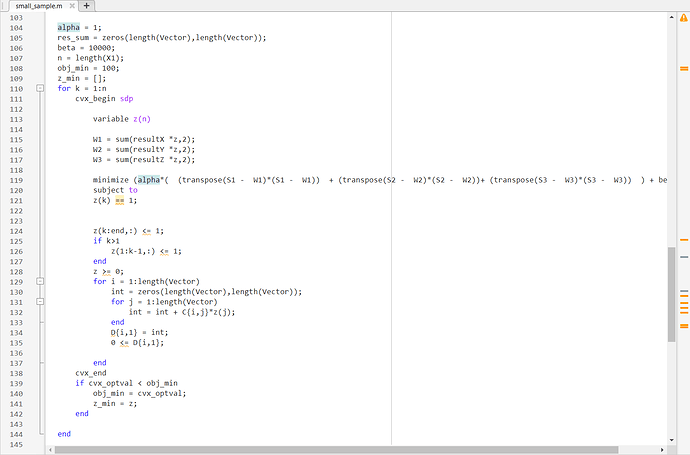Hello all. I am trying to solve the following algorithm however, MatLab did not return the correct result for it. Can anyone tell me what is the problem with my code?
Screenshot 2022-09-28 160718|423x499
Here, X is the N3 dimensions array. f_r is the r-th column of the eigenvector of XX^{T} which makes sure that X*X^{T} is a square matrix. V is the Vector in my code.
Here is the full code:
*close all
clear
clc
rng(‘default’)
q= rng;
tic
% Generating the sample
x = -0.5 + rand(4,1) ;
y = -0.5 + rand(4,1) ;
X4 = [];
X5 = [];
X8 = [];
X9 = [];
for i = 1:2
if ((x(i))^2 + (y(i))^2) <= 0.25
X4 = [X4,x(i)];
X5 = [X5,y(i)];
end
end
for j = 3:4
if ((x(j))^2 + (y(j))^2) <= 0.25
X8 = [X4,x(j)];
X9 = [X5,y(j)];
end
end
X6 = zeros(1,length(X4)) ;
X7 = 1 * ones(1,length(X8));
radius = 0.5 * ones(1,2);
theta = 2rand(2,1);
X1 = diag(radius) * cos(thetapi);
X2 = diag(radius) * sin(thetapi);
X3 = 1rand(2,1);
X1 = vertcat(X1,X4’,X8’);
X2 = vertcat(X2,X5’,X9’);
X3 = vertcat(X3,X6’,X7’);
X = horzcat(X1,X2,X3); % sample
%algorithm 1
S = X - mean(X,2);
S1 = S(:,1);
S2 = S(:,2);
S3 = S(:,3);
R_s = S * S’;
[Vector,Value] = eig(R_s);
Vector = real(Vector);
s = length(X);
resultX = zeros(length(X),length(X));
resultY = zeros(length(X),length(X));
resultZ = zeros(length(X),length(X));
for i = 1:s
parX = (transpose(Vector(:,i)) * X(:,1)) * (Vector(:,i));
resultX(:,i) = parX;
parY = (transpose(Vector(:,i)) * X(:,2)) * (Vector(:,i));
resultY(:,i) = parY;
parZ = (transpose(Vector(:,i)) * X(:,3)) * (Vector(:,i));
resultZ(:,i) = parZ;
end
result = zeros(length(X),length(X));
C = {};
for i = 1:length(Vector)
res = kron(Vector(:,i),transpose(Vector(:,i)));
for j = 1:length(Vector)
result = res*Vector(j,i);
C{j,i} = result;
end
end
D = {};
alpha = 1;
res_sum = zeros(length(Vector),length(Vector));
beta = 10000;
n = length(X1);
obj_min = 100;
z_min = [];
for k = 1:n
cvx_begin sdp
variable z(n)
W1 = sum(resultX *z,2);
W2 = sum(resultY *z,2);
W3 = sum(resultZ *z,2);
minimize (alpha*( (transpose(S1 - W1)*(S1 - W1)) + (transpose(S2 - W2)*(S2 - W2))+ (transpose(S3 - W3)*(S3 - W3)) ) + beta*z'*z);
subject to
z(k) == 1;
z(k:end,:) <= 1;
if k>1
z(1:k-1,:) <= 1;
end
z >= 0;
for i = 1:length(Vector)
int = zeros(length(Vector),length(Vector));
for j = 1:length(Vector)
int = int + C{i,j}*z(j);
end
D{i,1} = int;
0 <= D{i,1};
end
cvx_end
if cvx_optval < obj_min
obj_min = cvx_optval;
z_min = z;
end
end
